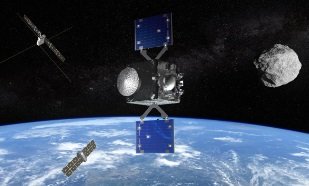
The European Space Agency (ESA) has embarked on the initial planning stages of a critical mission, the Rapid Apophis Mission for Space Safety (RAMSES). This project aims to closely examine Apophis, a massive near-Earth asteroid officially designated as asteroid (99942). Scheduled to arrive at its target in February 2029, the RAMSES mission will coincide with NASA’s own mission, Osiris-Apex, which has also set its sights on Apophis. Together, these missions represent a concerted effort to deepen our understanding of asteroid behavior and, ultimately, refine planetary defense strategies.
What Is Apophis?
Discovered in 2004, Apophis spans approximately 340 meters (1,115 feet) in diameter, large enough to cause significant damage should it collide with Earth. Fortunately, Apophis will pass safely by on April 13, 2029, at a distance of about 19,794 miles (31,860 kilometers) from Earth. Though not a direct threat, this close flyby will bring Apophis within a range suitable for high-resolution observations, making it a rare and valuable opportunity for scientists to study its physical and orbital characteristics.
Why Are Asteroids a Threat?
Asteroids, remnants of the solar system’s formation, orbit the Sun in vast numbers. Although many remain in the asteroid belt, some venture closer to Earth, posing a potential threat. Earth faces constant risk from these near-Earth objects (NEOs), which total roughly 35,000. Among them, about 2,300 are deemed “potentially hazardous” due to their size and proximity. While most NEOs are small, larger asteroids like Apophis carry the potential for massive destruction in the event of a collision.
Historical Impact of Asteroids
Earth has faced catastrophic asteroid impacts before, with some events reshaping the planet’s biological landscape. A notable example is the asteroid impact 66 million years ago, widely believed to have contributed to the extinction of the dinosaurs. If a large asteroid were to collide with Earth, the resulting release of energy would be devastating, comparable to multiple nuclear explosions. This historical context underscores the importance of tracking and understanding NEOs, particularly those of Apophis’s scale.
Tracking and Mitigating Asteroid Impacts
The scientific community employs advanced surveys and telescopes to locate and monitor potentially hazardous asteroids. However, identifying these threats is only the first step. Preparing for potential future collisions also requires developing methods to redirect or deflect an asteroid’s path if it is found to be on a collision course with Earth. Both RAMSES and NASA’s Osiris-Apex missions offer a chance to gather critical data that may one day inform these protective measures.
Mission Details: RAMSES and Osiris-Apex
The RAMSES mission will investigate changes in Apophis’s orbit, rotation, and shape as it passes near Earth, which will help scientists understand how gravitational forces affect asteroids. Concurrently, NASA’s Osiris-Apex mission will examine Apophis’s surface, with plans to disturb surface dust and analyze the asteroid’s layers. Together, RAMSES and Osiris-Apex may reveal insights essential for future planetary defense tactics, particularly in how to influence an asteroid’s trajectory in the event of a predicted collision.
A Rare Opportunity to Study Asteroids
The chance to observe an asteroid of Apophis’s size and proximity occurs only once every 5,000 to 10,000 years. This unique flyby offers a pivotal opportunity to gather detailed information that could ultimately prove vital in protecting Earth from future asteroid threats. Through this mission, scientists aim to unravel the complexities of asteroid composition, behavior, and potential vulnerabilities.
The Symbolic Connection to Egyptian Mythology
The mission names, RAMSES and Osiris-Apex, draw from ancient Egyptian mythology, which lends a symbolic layer to humanity’s ongoing efforts to defend against cosmic threats. Apophis, named for a mythical force of chaos and darkness, represents a dangerous and uncontrollable power in Egyptian lore. Just as the sun god Ra fought off Apophis to protect the world, these missions metaphorically embody humanity’s struggle to “conquer” potentially hazardous space objects, ensuring Earth’s safety through knowledge and innovation.
As RAMSES and Osiris-Apex prepare to meet Apophis in 2029, scientists and engineers around the world eagerly anticipate the wealth of data these missions will provide. This coordinated effort between ESA and NASA signifies a crucial step forward in planetary defense research, underscoring the power of international collaboration and scientific inquiry in safeguarding our planet.

